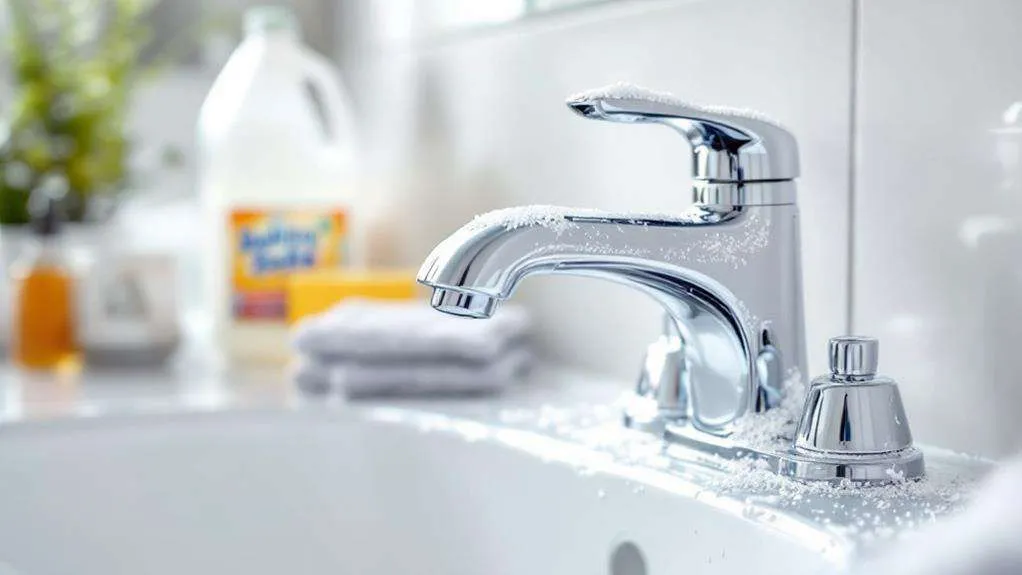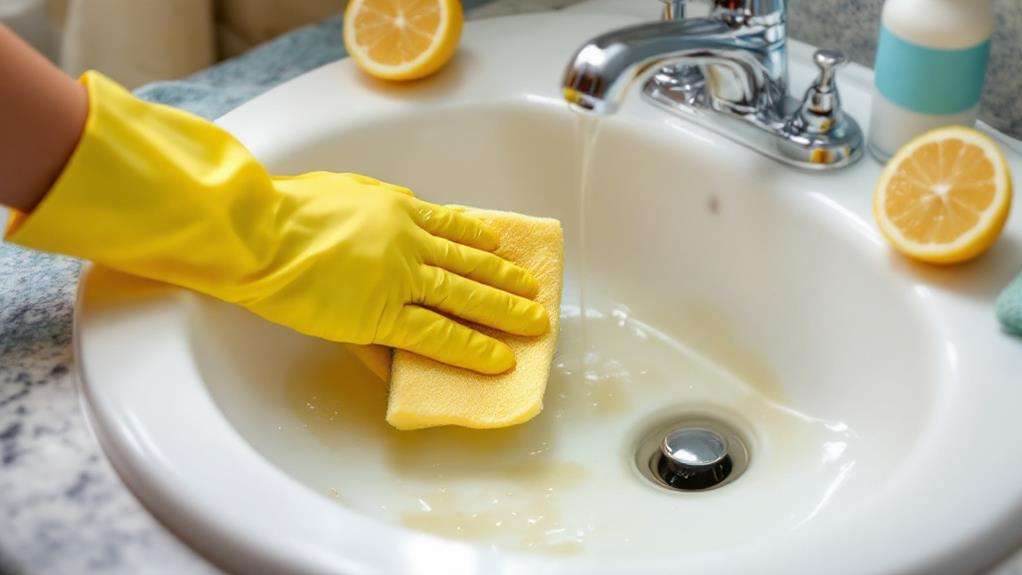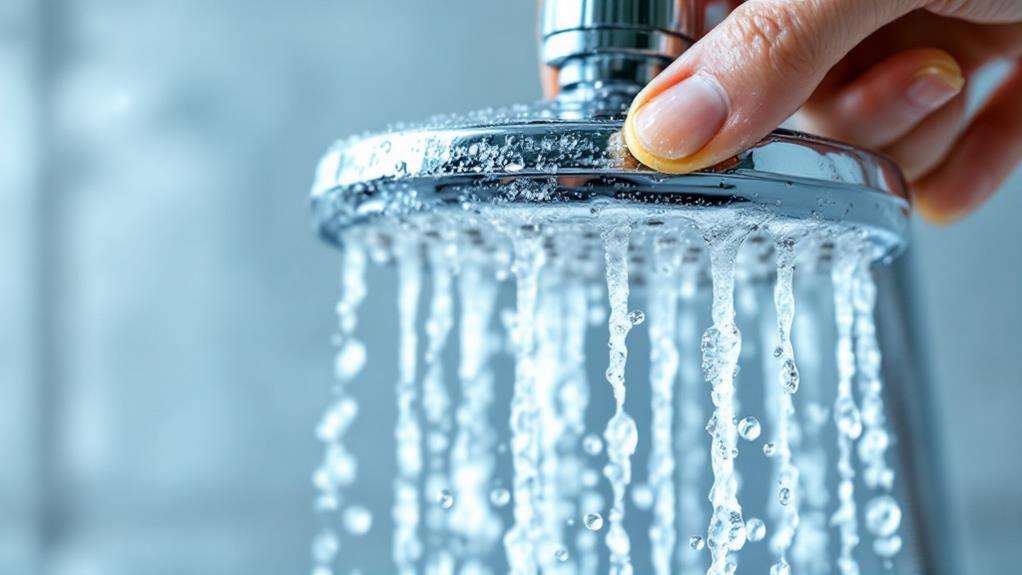How to Remove Hard Water Stains From Bathroom Fixtures and Toilets

To remove hard water stains from bathroom fixtures and toilets, start with a mixture of white vinegar and water. Apply this solution to affected areas and let it sit for 10-15 minutes. For tougher stains, create a paste using baking soda and water. Gently scrub with a non-abrasive sponge, then rinse thoroughly. For toilet bowls, pour vinegar into the bowl, add baking soda, and let it fizz before scrubbing. Don't forget to clean showerheads and faucets by soaking them in vinegar. To prevent future stains, wipe surfaces dry after use and consider investing in a water softener. Discover more techniques to keep your bathroom spotless and stain-free.
Key Takeaways
- Use a mixture of white vinegar and water to dissolve mineral buildup on fixtures and toilets.
- Create a paste with baking soda and water for more stubborn stains, letting it sit before scrubbing.
- For toilets, pour vinegar into the bowl, add baking soda, and let sit before scrubbing with a toilet brush.
- Clean showerheads and faucets by soaking them in vinegar or attaching vinegar-filled bags to non-removable fixtures.
- Prevent future stains by wiping surfaces after use and applying protective coatings or sealants to prone areas.
Understanding Hard Water Stains
Hard water stains are stubborn mineral deposits that form when water with high mineral content evaporates, leaving behind calcium and magnesium residue. These unsightly marks can appear on various bathroom fixtures, including your shower, bathtub, and toilet. The severity of hard water stains depends on the water's hardness level, which is determined by the concentration of dissolved minerals.
You'll often notice hard water stains as white, chalky spots or streaks on surfaces that regularly come into contact with water. In some cases, these stains may even have a slightly rough texture. The longer you leave them untreated, the more difficult they become to remove.
Hard water stains aren't just a cosmetic issue; they can also impact the functionality of your bathroom fixtures. Over time, mineral buildup can clog showerheads, reduce water flow, and even damage plumbing. Understanding the nature of these stains is crucial for effective prevention and removal. By recognizing the signs of hard water stains early, you can take action to protect your bathroom fixtures and maintain their appearance and performance.
Effective Cleaning Solutions
For tackling hard water stains, you'll need effective cleaning solutions that can break down mineral deposits without damaging your fixtures. One of the most popular and cost-effective methods for removing hard water stains is using a mixture of white vinegar and water. This acidic solution can effectively dissolve mineral buildup on various surfaces.
For stubborn hard water stains, you can create a baking soda paste by mixing it with a small amount of water. Apply this paste to the affected area and let it sit for about 15 minutes before scrubbing. Here's a simple process to Clean Hard Water Stains:
- Apply your chosen cleaning solution to the stained area
- Allow the solution to sit for 10-15 minutes
- Scrub the area gently with a non-abrasive sponge
- Rinse thoroughly and dry the area completely
For extremely tough stains, you may need to repeat the process or try a commercial hard water stain remover. Always test any cleaning solution on a small, inconspicuous area first to ensure it won't damage your fixtures. Remember to wear gloves and work in a well-ventilated area when using cleaning products.
Removing Stains From Sinks

Now that you're equipped with effective cleaning solutions, let's focus on removing hard water stains from sinks. Tough hard water spots can be stubborn, but you've got several options to tackle them. Start with a simple vinegar and water solution, which effectively breaks down mineral deposits. Apply it to the stained areas and let it sit for a few minutes before scrubbing.
For more stubborn spots, create a paste using baking soda and water. Apply this mixture to the hard water stains and scrub gently. This method is particularly effective for removing water stains from showers and sinks alike. If you're dealing with a stainless steel sink, try a paste made from lemon juice and baking soda to lift discoloration.
For the toughest hard water spots, consider using commercial cleaners containing acids or chelating agents. These are specifically formulated to remove hard water stains and can be highly effective. To prevent hard water buildup in the future, wipe down your sink after each use and apply a protective sealant. By incorporating these cleaning methods and preventive measures, you'll keep your sinks looking spotless and free from unsightly mineral deposits.
Tackling Toilet Bowl Buildup
Toilets often bear the brunt of hard water buildup, creating unsightly stains and rings that can be tough to remove. To tackle even the most stubborn stains in your toilet, follow these steps:
- Start by pouring a cup of white vinegar into the bowl. Spread it around using a toilet brush, making sure to submerge the brush to coat the entire surface.
- Next, add a cup of baking soda to the bowl. You'll notice it fizzing as it reacts with the vinegar. Let the solution sit for about 15 minutes.
- While waiting, dampen some paper towels with vinegar and place them on any dried stains above the waterline. This will help soften the buildup.
- After 15 minutes, try scrubbing the bowl with a toilet brush. For tougher stains, use a pumice stone, gently rubbing in a circular motion.
If these steps don't completely rid of hard water stains, you can repeat the process or leave the vinegar and baking soda mixture overnight for more stubborn buildup. Remember to flush the toilet and rinse your cleaning tools thoroughly when you're done.
Cleaning Showerheads and Faucets

Hard water can wreak havoc on your showerheads and faucets, leaving behind unsightly mineral deposits and reducing water flow. To combat this issue, you'll need to tackle the dried mineral film left behind every time you use these fixtures. Start by removing detachable showerheads and faucet fixtures, then soak them in a vinegar solution to dissolve the buildup. For non-removable fixtures, spray them with a vinegar-based or specialized hard water stain remover, letting it sit before scrubbing.
If you can't remove your showerhead, try attaching a plastic bag filled with vinegar onto it and let it soak for several hours. This method effectively breaks down scale buildup. Don't forget to clean faucet aerators regularly by unscrewing and soaking them in vinegar to prevent clogging from hard water minerals.
To stop hard water stains from reoccurring, apply a protective coating or sealant to your fixtures' surfaces. This will make them more resistant to future staining. While vinegar and baking soda can be effective, sometimes specialized Home Water products designed for hard water removal may be necessary for stubborn stains. By maintaining your fixtures regularly, you'll keep them free from lathering products and mineral deposits.
Preventing Future Hard Water Stains
Preventing future hard water stains is just as important as removing existing ones. To keep your bathroom fixtures and toilets free from mineral buildup, you'll need to implement a proactive approach. Here are some tips and tricks to help you maintain a spotless bathroom:
- Invest in a whole-house water softener system to reduce water hardness. This system removes minerals before they reach your fixtures, preventing stains from forming in the first place.
- Wipe down surfaces immediately after use. Keep a small squeegee or microfiber cloth handy to quickly remove water droplets from your shower and bathtub, preventing evaporation and mineral deposits.
- Establish a consistent cleaning routine. Use a vinegar solution or baking soda paste daily to clean fixtures and prevent buildup. For added freshness, add a few drops of essential oil to your cleaning mixture.
- Apply a protective coating to surfaces prone to staining. This creates a barrier between the water and the fixture, making it harder for minerals to stick.
